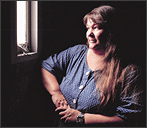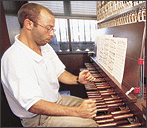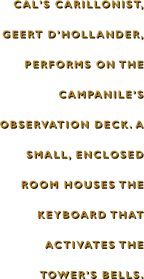

The Jane K. Sather Tower is undoubtedly the most famous building on campus.
Each year, more than 70,000 people visit it to photograph its picture-perfect facade, take in spectacular views from the open-air observation deck and hear music from one of the world's finest carillons. But they don't know there is a life within the tower.
 Surrounding the elevator shaft, the building's core, is a winding, dark staircase with more than 300 steps, tiny rooms with unusual contents and hauntingly beautiful melodies wafting through the inner walls.
Surrounding the elevator shaft, the building's core, is a winding, dark staircase with more than 300 steps, tiny rooms with unusual contents and hauntingly beautiful melodies wafting through the inner walls.
And while "the Campanile," as it is popularly called, is the world's third tallest bell and clock tower, just two people work inside. They alone know the stories the 84-year-old tower has to tell -- of romance, highjinks and danger.
Not just anyone can work in this confining and spooky space.
The "Mistress of the Tower," as she calls herself, is Lilyanne Clark. She operates the elevator, making as many as 150 runs a day to and from the tower's deck, which is the equivalent of 20 stories above ground.
In her unusual work environment, Clark, 51, with her long, flowing tresses, has fancied herself as Rapunzel. "But she was stuck in her tower," said Clark. "I can walk out."
Hardly a damsel in distress, Clark is the tower's protector. She scolds people who rocket items off the top, including engineering students with fancy model airplanes. She washes lipstick and handprints off the deck's glass panels. And she is quick to call police, giving an eyewitness account when protesters invade.
Clark also guards each of the six U-shaped floors, which are closed to the public. There is a seventh level -- a landing that leads to the deck. Floors two through five, where sooty-smelling rooms house contents worthy of a horror movie -- six tons of skeletons, stored on open shelving and in crates -- are her favorites.
Animal -- but not human -- bones, these are the blackened remains of Ice Age mammals, including giant sloths, saber-toothed tigers and camels, who met their fate in Southern California tar pits. The bones, which UC paleontologists began gathering in 1906, wound up in the tower after the Department of Paleontology ran out of storage space.
On the third floor, Clark gets a rare glimpse of daylight by opening one of only 24 windows in the tower. Each window is a tall, narrow slit, like those in castle walls. "I see the Golden Gate Bridge and San Francisco," she said, "and check on the weather."
Clark also is the Campanile's Cupid. More than once, a prospective groom with a flair for the dramatic has asked her help in orchestrating a marriage proposal on the deck. Once, a limousine parked below the tower sped a newly engaged couple off to a romantic picnic.
"Shervin has asked my hand in marriage today in Sather Tower," a woman wrote in Clark's Campanile guest book in 1994. "I accepted! Today marks the final bond between our two hearts. Forever I will love and honor Shervin. Hooray!"
The deck of the 307-foot-tall tower is used, too, for religious meditation, said Clark, and for student pranks. It's a place to leave your worries behind, she added, or to vent them with a good cry.
Several years ago, a re-entry student who had just flunked her first midterm came to the tower to shed tears. The elevator operator offered a sympathetic ear on the woman's ride down.
"She was on the way to Letters & Science to see about withdrawing from school," Clark wrote in a diary she keeps in the tower. But in 1997, the woman returned to the Campanile to thank Clark for the pep talk. She'd graduated from UC Berkeley the previous year.
The tower's second resident is Geert D'hollander, the campus carillonist, who often works there from 9 a.m. until midnight. The son of a carillonist, he grew up in Belgium following his father up and down the steps of church bell towers.
"Bell towers are more scary in Europe," said D'hollander, who at age 33 is considered one of the best carillonists in the world. "There are secret doors, bats, owls and antiques from churches stuffed into passageways. It's an adventure at every corner."
By contrast, he said, working in the Campanile, "is pure luxury."
On the sixth floor, D'hollander's office has a desk, sofa, piano, shower, kitchenette, computer and fax machine. There even is a mini carillon on which he practices his music. To do research, D'hollander goes to his private library on the first floor.
In addition to the ringing of its 61 bells, the tower generates other sounds -- some of them eerie. D'hollander's practice carillon and two others can't be heard outdoors, but in the empty stairwells the melodies are strange and tinkling, like those from a music box.
Every 60 seconds, the tower is filled with a loud, whooshing sound as the giant clock's gears move ahead. And occasionally, an inexplicable noise startles even D'hollander.
"What was that?" he recently asked about a thumping noise coming from the floor.
Not many people would willingly work in a bell tower after dark. But D'hollander said he's not afraid.
"The nicest time here is when it gets dark," he said. "I often go to the top and look at the view. It's astonishing at night, when it's clear. I feel very lucky to see such a view. If you're up there, you feel so free. It gives you a kick."
by Gretchen Kell
![]()


[Table of Contents] [Berkeley Magazine Home] [UC Berkeley Home Page]
Copyright 1998, Regents of the University of California. All rights reserved.
Comments? E-mail ucbwww@pa.urel.berkeley.edu.